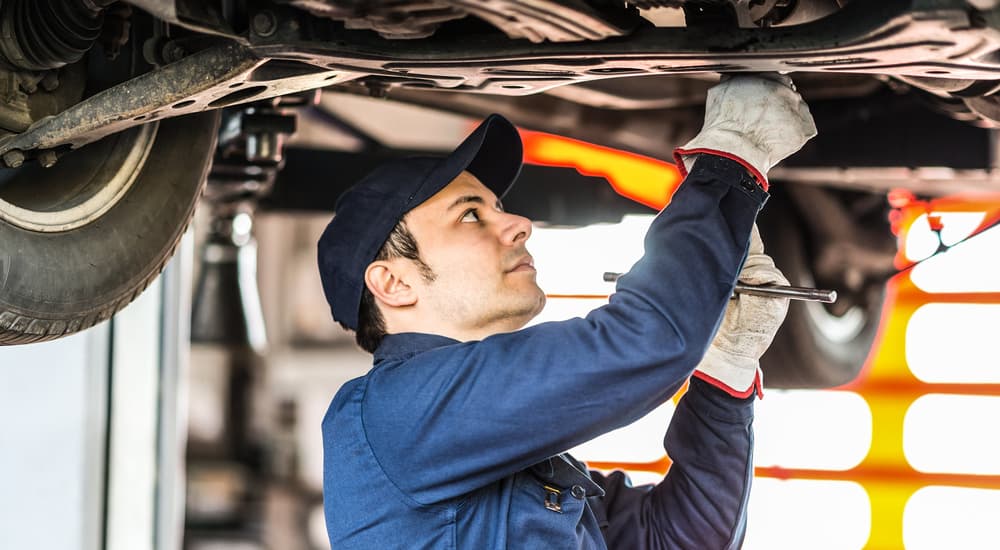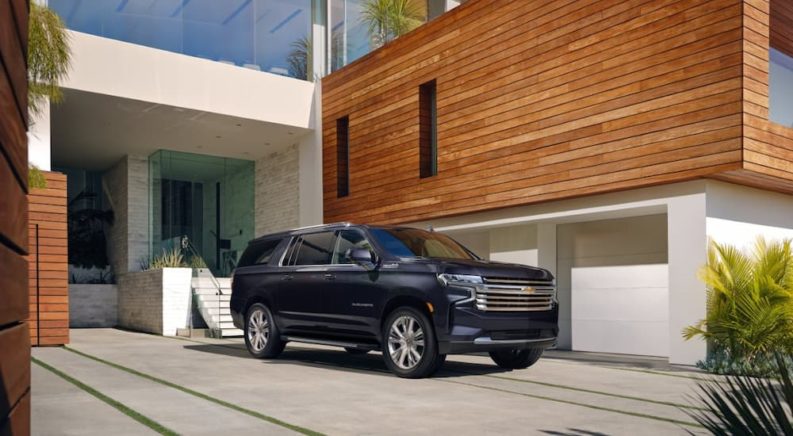The Suburban is the largest SUV in Chevy’s lineup, and if you take care of it properly, it can keep you and your family on the road for a long time. Whether you just bought a 2022 Chevy Suburban or you’re thinking about it, and you’re curious about what kind of maintenance schedule you might be looking at in the years to come, I’m here to help. For the most part, caring for a Suburban is just like any other vehicle, and you’re not going to be too shocked by anything you find here regarding when and what to do.
That being said, it’s still very important that you follow the guidelines and schedule established by the manufacturer of your vehicle, in this case, that’s Chevrolet. They made your SUV, so they know the best way to keep it in great shape. Even though I’m going off of their recommendations, you should still check your Suburban owner’s manual to make sure you’re following the proper maintenance and service routine. And, of course, if anything feels off, a warning light comes on, or you notice any strange sounds or smells, then you should have your Suburban checked out and serviced right away.
Maintenance Schedule Basics
Before we look at the specific schedules for the Chevy Suburban, let’s go over a few basics that you should keep in mind while caring for your vehicle. For starters, these schedules are meant for a Suburban model with a gas engine – if you have one or you’re planning on getting one with a diesel engine, then that requires slightly different care. It’s also worth noting that this is meant as a general guideline for when to have work done so that you don’t go too long without properly caring for your vehicle. In other words: this is meant for a best-case scenario where you drive carefully, avoid potholes and curbs, and generally take good care of your SUV.
I should also mention that the work in the maintenance schedules needs to be done by a trained professional who knows how to work on Chevy vehicles. Some of this stuff you can do yourself, especially with some practice and experience–though some tasks are definitely more complicated than others. Just remember that a new model like a 2022 Chevy Suburban is under a couple of different warranties from the manufacturer. Any work that’s done by someone other than a Chevy-certified service professional can potentially void one of those warranties or at least won’t be covered if you need to have a mistake fixed.
Finally, you’ll notice that there are two different schedules for maintenance set by Chevrolet for the Suburban. This depends on the kind of use and general wear and tear you put on your vehicle by driving each day. According to Chevy’s definitions, “Normal” use includes driving on reasonable road surfaces within legal speed limits, staying within recommended weights for tire load, and using the fuel they recommend. In contrast, “Severe” use involves driving in heavy city traffic and hot conditions, driving in hilly or mountainous terrain, frequently towing a trailer, driving at high speeds or racing, and using your Suburban for taxi or delivery service.

Normal Maintenance Schedule
There’s some overlap between the two schedules, but to keep things simple, I’m going to give them as provided by Chevy in full – so apologies in advance for repetition. According to Chevy, you should do the following at these mileage and time milestones:
- Every 7,500 miles – Rotate your tires and perform “Required Service.”
- Every 15,000 miles (or every year) – Replace front and rear wiper blades.
- Every 22,500 miles (or every 2 years) – Replace the cabin air filter.
- Every 75,000 miles (or every 10 years) – Replace the hood support gas strut.
- Every 97,500 miles – Inspect spark plug wires and replace spark plugs. Change transfer case fluid if equipped with 4WD.
- Every 150,000 miles (or every 5 years) – Replace engine coolant, inspect the accessory drive belt, and replace the brake fluid.
- Every 7 years (no mileage indicated) – Replace the air conditioning desiccant.
For the “Required Service” every 7,500 miles, Chevy includes:
- Checking the engine oil level and oil filter
- Checking the engine air filter
- Checking tire pressure and wear
- Checking the windshield wiper fluid
- Checking the engine coolant
- Checking the fuel system
- Checking for fluid leaks and inspecting the brake system
- Checking the steering, suspension, brakes, and driveshafts
The gas struts mentioned for every 75,000 miles is the mechanism that holds the hood and trunk open for you, which can fail over time and needs to be replaced for safe use. I should also mention that when Chevy indicates both mileage and a time span, these are “whichever comes first” conditions. So if you don’t tend to put a lot of miles on your vehicle, you might not hit more than 22,000 miles over the course of two years, but you should still replace the air filter for the cabin. Down below, I’ll go over how to properly have your tires rotated to keep them in great shape and ensure they wear evenly together.
Severe Maintenance Schedule
If you tend to put more wear on your vehicle, then you’ll want to follow Chevy’s maintenance schedule for “severe” use. To be honest, this can include a lot of people who probably don’t think they’re putting severe use on their vehicle, especially with so many drivers getting income from ridesharing and food delivery services these days. Even simply driving to work each day in a hot environment like Arizona or Texas would be enough to qualify for the “severe” maintenance schedule, so keep that in mind. According to Chevy, here’s what you need to do:
- Every 7,500 miles – Rotate your tires and perform “Required Service.”
- Every 15,000 miles (or every year) – Replace front and rear wiper blades.
- Every 22,500 miles (or every 2 years) – Replace the cabin air filter.
- Every 45,000 miles (or every 4 years) – Change the transmission fluid and change transfer case fluid if equipped with 4WD.
- Every 75,000 miles (or every 10 years) – Replace the hood support gas strut.
- Every 97,500 miles – Inspect spark plug wires and replace spark plugs.
- Every 150,000 miles (or every 5 years) – Replace engine coolant, inspect the accessory drive belt, and replace the brake fluid.
- Every 7 years (no mileage indicated) – Replace the air conditioning desiccant.
For the most part, there are very few differences between the maintenance schedules for the two different driving conditions. The biggest thing is that the severe schedule includes an instruction to change the automatic transmission fluid, which is missing from the other schedule. No matter what your driving conditions, however, that seems like something to keep in mind and have replaced on a scheduled basis.

Proper Tire Rotation
One of the procedures that’s required most frequently according to Chevy’s service schedule for the Suburban is rotating your tires. This is something that’s quite easy to have a service professional handle for you, though you can do it yourself with the proper equipment to lift your vehicle. If you can change your own tires, then you can rotate them–though it’s important to do it in the proper way to ensure the best overall wear.
The point of rotating your tires is to make sure all four are wearing evenly, which helps you maintain the best traction and control on the road. This also means that when it’s time to replace your tires, you can replace all four of them at once–this might seem like it would cost more money, but you can often find service centers with deals on four tires compared to just two. At the bare minimum, you should replace your tires in pairs and if you only want two, then place the two new tires on the rear axle.
Rotating your tires is simple: move the rear tires to the front axle, keeping them on the same side, and move the front tires to the rear, switching sides as you do. So your front-left tire becomes your rear-right, your front-right becomes your rear-left, and the two rear tires just go straight forward to the front axle. This ensures the most even overall wear as you drive. When you do get new tires, be sure to choose the same size on them: the Suburban comes with 18-inch, 20-inch, and 22-inch wheels; you want to be sure you pick the correct tire size for the wheels on your vehicle and go with a brand you can trust.

